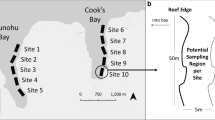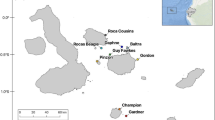Abstract
Acropora provides an example of reef degradation, as evidenced by population reductions in Caribbean reefs. However, data on the current status of Acropora populations in Colombia are lacking. In this study, reef habitats were surveyed for Acropora palmata and Acropora cervicornis throughout the Colombian Caribbean, and the size structure, coverage and colony conditions of their populations were evaluated. Acropora palmata size classes were negatively skewed, indicating low recruitment. This species exhibited a patch-type distribution around Tayrona, Isla Fuerte and Isla Arena; these localities exhibited the highest cover among the surveyed regions. The lowest coral cover was recorded for the Rosario Islands. Healthy colonies were dominant; however, disease and damselfish territories were common. The size class data of Acropora cervicornis indicated the persistence of small colonies; however, no recruits were observed. The distribution was dispersed, with important patches and the highest cover observed around the Urabá Gulf and Rosario Islands. Overall, the cover was lower than 10%. Few healthy colonies were observed, and macroalgae and sponges were common. Conservation and management efforts are required for both species; for Acropora palmata, efforts targeting the Rosario Islands are needed, whereas Acropora cervicornis is in critical condition throughout the Colombian Caribbean.





Similar content being viewed by others
References
Adjeroud, M., M. S. Pratchett, M. C. Kospartov, C. Lejeusne & L. Penin, 2007. Small-scale variability in the size structure of scleractinian corals around Moorea, French Polynesia: patterns across depths and locations. Hydrobiologia 589: 117–126.
Alvarado, E. M., L. Duque, L. Flórez & R. Ramírez, 1986. Evaluación cuantitativa de los arrecifes coralinos de las islas del Rosario (Cartagena, Colombia). Boletín Econtropica 15: 1–30.
Anderson, K. D. & M. S. Practchett, 2014. Variation in size-frequency distributions of branching corals between a tropical versus sub-tropical reef. Marine Ecology Progress Series 502: 117–128.
Ardila, N., G. R. Navas & J. Reyes, 2002. Libro rojo de invertebrados marinos de Colombia. Bogotá, Colombia: INVEMAR y Ministerio del Medio Ambiente. La serie de Libros Rojos de Especies Amenazadas de Colombia, 180 p
Aronson, R. B, A. W Bruckner, J. Moore, W.F. Precht & E. Weil, 2008a. IUCN Red List of Threatened Species: Acropora palmata. Retrieved from www.iucnredlist.org.
Aronson, R. B., A. W Bruckner, J. Moore, W. F Precht & E. Weil, 2008b. IUCN Red List of Threatened Species: Acropora cervicornis. Retrieved from www.iucnredlist.org
Babcock, R. C., 1991. Comparative demography of three species of scleractinian corals using age and size dependent classifications. Ecological Monographs 61: 225–244.
Baird, A. H. & T. P. Hughes, 1997. Spatial variation in coral recruitment around Lizard Island. Proceedings of 8th International Coral Reef Symposium 2: 1207–1210
Bak, R. P. M. & E. H. Meesters, 1998. Coral population structure: the hidden information of colony size-frequency distributions. Marine Ecology Progress Series 162: 301–306.
Banaszak, A. T. & M. P. Lesser, 2009. Effects of solar ultraviolet radiation on coral reef organisms. Phothochemical Photobiology Science 8: 1276–1294.
Bayraktarov, E., V. Pizarro & C. Wild, 2014. Spatial and temporal variability of water quality in the coral reefs of Tayrona National Natural Park, Colombian Caribbean. Environmental Monitory Assess 186: 3641–3659.
Buddemeier, R. W., J. R. Ware, T. A. Gardner, I. M. Côté, J. A. G. Gill, A. Grant & A. R. Watkinson, 2003. Coral reef decline in the Caribbean. Science 302: 391–393
Buddemeier, R. W., J. A. Kleypas, & R. B Aronson. 2004. Coral reefs & Global climate change. Potential contributions of climate change to stresses on coral reef ecosystems. Pew Center on Global Climate Change. Arlington VA. 44p
Bruckner, A. W. 2002. Proceedings of the Caribbean Acropora Workshop: Potential Application of the U.S. Endangered Species Act as a Conservation Strategy. NOAA Technical Memorandum NMFS-OPR-24, Silver Spring, MD, 199 pp.
Cendales, M.H., S. Zea & J.M. Díaz, 2002. Geomorfología y unidades ecológicas del complejo de arrecifes de las Islas del Rosario e Isla Barú (Mar Caribe, Colombia). Revista de la Academia Colombiana de Ciencias 26(101): 497–510.
Croquer, A., F. Cavada-Blanco, A. L. Zubillaga, E. A. Agudo-Adriani & M. Sweet, 2016. Is Acropora palmata recovering? A case study in Los Roques National Park, Venezuela. PeerJ 4: 1539.
Díaz, J. M., J. A. Sánchez & G. Díaz-Pulido, 1996. Geomorfología y formaciones arrecifales recientes de Isla Fuerte y Bajo Bushnell, Plataforma continental del Caribe colombiano. Boletín de Investigaciones Marinas y Costeras 25: 87–105.
Díaz, J. M., L. M. Bárrios, M. H. Cendales, J. Garzón-Ferreira, J. Geister, M. López-Victoria, G. H. Ospina, F. Parra-Velandia, J. Pinzón, B. Vargas-Ángel, F. Zapata & S. Zea, 2000. Áreas coralinas de Colombia. Serie Publicaciones Especiales No. 5. Instituto de Investigaciones Marinas y Costeras. INVEMAR 175p
Gardner, T., I. M. Côte, J. Gill, A. Grant & A. Watkinson, 2003. Long-term region-wide declines in Caribbean corals. Science 301: 958–960.
Garzón-Ferreira, J. & M. Cano. 1991. Tipos, distribuci6n, extensi6n y estado de conservación de los ecosistemas marinos costeros del Parque Nacional Natural Tayrona. Unpubl. Report, VII Concur. Nal. Ecol., FEN/INVEMAR, Bogotá/Santa Marta. 82 p.
Garzón-Ferreira, J., D. L. Gil-Agudelo, L. M. Barrios & S. Zea, 2001. Stony coral diseases observed in southwestern Caribbean reefs. Hydrobiologia 460: 65–69.
Garzón-Ferreira, J., M. Moreno-Bonilla & J. M. Valderrama, 2004. Condición actual de las formaciones coralinas de Acropora palmata y A. cervicornis en el Parque Nacional Natural Tayrona (Colombia). Boletín de Investigaciones Marinas y Costeras 33: 117–136.
Gleason, D. F. & G. M. Wellington, 1993. Ultraviolet radiation and coral bleaching. Nature 365: 836–838.
Hall, A., A. D. Miller, H. Legget, S. Roxburgh, A. Buckling & K. Shea, 2012. Diversity–disturbance relationship: frequency and intensity interact. Biological Letters 8: 768–771.
Hughes, T. P., 1984a. Population dynamics based on individual size rather than age: a general model with a reef coral example. The American Naturalist 123: 778–795.
Hughes, T., 1984b. Population dynamics based of individual size rather than age: a general model with a reef coral example. The American Naturalist 123: 277–293.
Hughes, T. P. & J. E. Tanner, 2000. Recruitment failure, life histories and long-term decline of Caribbean corals. Ecology 81: 2250–2263.
Hoegh-Guldberg, O., 1999. Climate change, coral bleaching and the future of the World’s Coral Reefs. Marine Freshwater Research 50: 839–866.
Kohler, K. E. & S. M. Gill, 2006. Coral point count with excel extensions (CPCe): a visual basic program for the determination of coral and substrate coverage using random point count methodology. Computer & Geoscience 32: 1259–1269.
Linares, C., M. S. Pratchett & D. J. Coker, 2011. Recolonisation of Acropora hyacinthus following climate-induced coral bleaching on the Great Barrier Reef. Marine Ecology Progress Series 438: 97–104.
Martínez, S. & A. Acosta, 2005. Cambio temporal en la estructura de la comunidad coralina del áres de Santa Marta-Parque Nacional Natural Tayrona (Caribe colombiano). Boletín de Investigaciones Marinas y Costeras 34(161): 191.
McManus, J. W. & J. F. Polsenberg, 2004. Coral–algal phase shifts on coral reefs: ecological and environmental aspects. Progress in Oceanography 60: 263–279.
Meesters, E. H., M. Hilterman, E. Kardinaal, M. de Vries Keetman & R. P. M. Bak, 2001. Colony size-frequency distributions of scleractinian coral populations: spatial and interspecific variation. Marine Ecology Progress Series 209: 43–54.
Meltvedt, A. & C. Jadot, 2014. Progression of the coral-algal phase shift in the Caribbean: a case study in Bonaire, Dutch Caribbean. Marine Technological Society Journal 48: 33–41.
Muller, E., C. Rogers, A. Spitzack & R. van Woesik, 2008. Bleaching increases likelihood of disease on Acropora palmata (Lamarck) in Hawksnest Bay, St John, US Virgin Islands. Coral Reefs 27: 191–195.
Nepote, E., C. N. Bianchi, M. Chiantore & M. Montefalcone, 2016. Pattern and intensity of human impact on coral reefs depend on depth along the reef profile and on the descriptor adopted. Estuarine Coastal and Shelf Science 178: 86–91.
Patterson, K. L., J. W. Porter, K. E. Ritchie, S. W. Polson & E. Mueller, 2002. The etiology of white pox, a lethal disease of the Caribbean elkhorn coral, Acropora palmata. Proccedings of the National Academy of Scienes USA 99: 8725–8730.
Pinzón, J. H., A. Perdomo & J. M. Díaz, 1998. Isla Arena, una formación coralina saludable en el área de influencia de la pluma del río Magdalena, Plataforma continental del Caribe colombiano. Boletín de Investigaciones Marinas y Costeras 27: 21–37.
Porter, J. W., P. Dustan, W. C. Jaap, K. L. Patterson, V. Kosmynin, O. W. Meier, M. E. Patterson & M. Parsons, 2001. Patterns of spread of coral disease in the Florida Keys. In Porter, J. (ed.), The ecology and etiology of newly emerging marine diseases. Springer, Netherlands: 1–24.
Rodríguez-Ramírez, A., M. C. Reyes-Nivia, R. Navas-Camacho, S. Bejarano, J. Garzón-Ferreira & F. Zapata, 2006. Status of the coral reefs of Colombia in 2003. Proceedings 10th International Coral reef symposium 976–981
Rodríguez-Ramirez, A., M. C. Reyes-Nivia, S. Zea, R. Navas-Camacho, J. Garzón-Ferreira, S. Bejarano, P. Herrón & C. Orozco, 2010. Recent dynamics and condition of coral reefs in the Colombian Caribbean. Revista Biologica Tropical 58: 107–131.
Rodríguez-Martínez, R. E., A. T. Banaszak, M. D. McField, A. U. Beltrán-Torres & L. Álvarez-Filip, 2014. Assessment of Acropora palmata in the Mesoamerican Reef System. PLoS ONE 9: e96140.
Rogers, C. S. & E. M. Muller, 2012. Bleaching, disease and recovery in the threatened scleractinian coral Acropora palmata in St. John, US Virgin Islands: 2003–2010. Coral Reefs 31: 807–819.
SiSMAC. Sistema de Soporte al Monitoreo de las Áreas Coralinas. (Datos Monitoreo Áreas Coralinas). http://siam.invemar.org.co/sismac
Smith, L. D., M. Devlin, D. Haynes & J. P. Gilmoure, 2005. A demographic approach to monitoring the health of coral reefs. Marine Pollution Bulletin 51: 399–407.
Vega-Sequeda, J., A. Rodríguez-Ramírez, M. C. Reyes-Nivia & R. Navas-Camacho, 2008. Formaciones coralinas del area de Santa Marta: estado y Patrones de distribución espacial de la comunidad béntica. Boletín de Investigaciones Marinas y Costeras 37: 87–105.
Vermeij, M. J. A. & R. B. Bak, 2003. Species-specific populations structure of closely related coral morphospecies along a depth gradient (5–60 M) over a Caribbean reef slope. Bulletin of Marine Science 73: 725–744.
Walker, B. K. & D. S. Gilliam, 2013. Determining the extent and characterizing coral reef habitats of the Northern Latitudes of the Florida reef tract (Martin county). PLoS ONE 8(11): e80439
Wallace, C. C., 1985. Reproduction, recruitment and fragmentation in nine sympatric species of the coral genus Acropora. Marine Biology 88: 217–233.
Wirt, K. E., P. Hallock, D. Palandro & K. L. Daly, 2013. Potential habitat of Acropora spp. on Florida reefs. Applied Geography 39: 118–127.
Wirt, K. E., P. Hallock, D. Palandro, K. D. Semon & K. Lunz, 2015. Potential Habitat of Acropora spp. on Reefs of Florida, Puerto Rico, and the US Virgin Islands. Global Ecology and Conservation 3: 242–255.
Yap, H. T., P. M. Aliño & E. D. Gomez, 1992. Trends in growth and mortality of three coral species (Anthozoa: Scleractinia), including effects of transplantation. Marine Ecology Progress 83: 91–101.
Zubillaga, A. L., L. M. Márquez, A. Cróquer & C. Bastidas, 2008. Ecological and genetic data indicate recovery of the endangered coral Acropora palmata in Los Roques, Southern Caribbean. Coral Reefs 27: 63–72.
Acknowledgements
This work was funded by the project “Acropora: a key genus for conservation. Genetic diversity, connectivity and ecological updating of Acropora populations in the Colombian Caribbean” COLCIENCIAS (code 11177141011) and the University of Magdalena. We are grateful to the National Natural Parks Unit of Colombia (permit 001, March 6, 2017) and the research group Ecology and Diversity of Marine Algae and Coral Reefs.
Author information
Authors and Affiliations
Corresponding author
Additional information
Handling editor: Iacopo Bertocci
Publisher's Note
Springer Nature remains neutral with regard to jurisdictional claims in published maps and institutional affiliations.
Electronic supplementary material
Below is the link to the electronic supplementary material.
10750_2020_4238_MOESM1_ESM.xls
Supplementary material S1. Reef sites at which Acropora palmata and A. cervicornis were recorded along the Colombian Caribbean from 2016-2018 (XLS 35 kb)
Rights and permissions
About this article
Cite this article
García-Urueña, R., Garzón-Machado, M.A. Current status of Acropora palmata and Acropora cervicornis in the Colombian Caribbean: demography, coral cover and condition assessment. Hydrobiologia 847, 2141–2153 (2020). https://doi.org/10.1007/s10750-020-04238-6
Received:
Revised:
Accepted:
Published:
Issue Date:
DOI: https://doi.org/10.1007/s10750-020-04238-6




